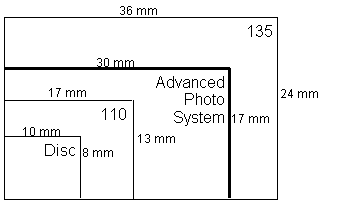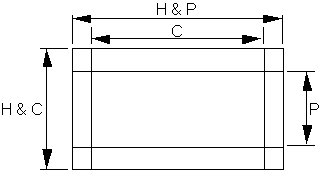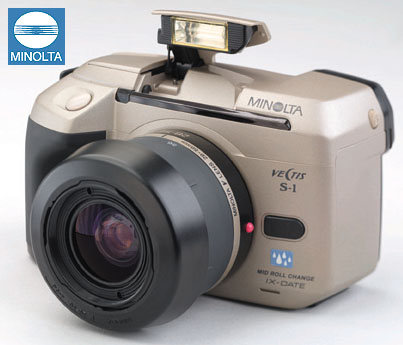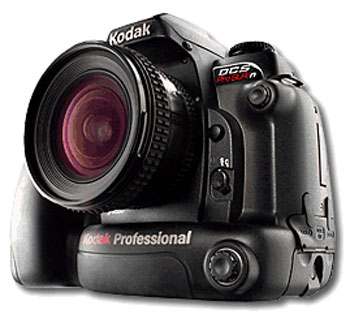The Digital Sensor: A Guide to Understanding Digital Cameras
by Wesley Fink on April 21, 2008 1:00 AM EST- Posted in
- Digital Camera
Why All these Different Sensor Sizes?
35mm first appeared on the scene in the 1930s and the film format simply took 35mm motion picture film and spooled it into a light-tight canister. By the 1960s, with point-and-shoot and developments in SLR technology, 35mm had become king of the film formats. Even as film manufacturers tried to introduce other film formats, 35mm continued to grow and prosper.
The SLR evolved in 35mm space and the world appeared orderly on the surface, but the only real constant was the size of the film. It was 35mm, but SLR manufacturers each championed their own lens mount and their exclusive lens line for their SLR film cameras. The primary advantage of the SLR was the ability to look through a wide variety of interchangeable lenses, and to accurately focus, meter, and later auto-focus through the viewing lens. As in today's digital SLR market, each manufacturer had their own lens mount, and lenses developed for one mount would not fit and work on others, i.e. a Nikon lens would not fit or work on a Canon camera.
APS (Advanced Photo System)
With the very early developments in digital photography, Kodak, Fuji, and others saw the handwriting on the wall for film photography. One of the ongoing complaints about 35mm film, however, has been that the 2:3 image format required image loss in almost every standard print size. Neither 8x10 nor 5x7 is a 2:3 ratio and both required cropping of the 35mm negative.

In 1996 a new APS (Advanced Photo System) initiative by Kodak, Fujifilm, Minolta, Nikon, Canon, and others was introduced to save film by standardizing on new ratios and adding new "computer-like" data storage capabilities in the taking and processing of film images. APS included a new film size - 30.2mm x 16.7mm - that could be printed full-frame (H or HDTV format), or use standard crops of 25.1mm x 16.7mm (C or Classic 2:3 format) or 9.5mm x 30.2mm (P or Panorama). Actually, the image size that was always shot was the 30.2mm x 16.7mm, and the other sizes were just standard crops.

The industry was confident they could sell APS, which in the most common C view was only about 55% of the already small 35mm size. Some manufacturers like Minolta developed new APS lens lines with smaller cameras and lenses, and Canon and Nikon developed APS camera bodies that could mount their regular lenses - and a few custom APS lenses.

In the end, APS failed in the film market. Industry pundits generally say APS failed because the negative was just too small, but it is more likely that it failed because it was just too late. Digital was on the near horizon, and many photographers did embrace smaller digital sensors while they rejected the smaller APS film format.
APS film is not that important in our discussion of digital photography, but the APS standard is important because it was also a standard for digital development. At the time of the APS initiatives, it seemed reasonable to aim for development of digital sensors for that same APS format, so lenses for both systems were interchangeable.
Most in the industry aimed for the APS C size sensor, which would be about 16.7mm x 25.1mm - the same ratio (2:3) as the classic 35mm format. Most manufacturers, burned by bad decisions in the APS film debacle, decided to keep their existing 35mm mounts, so their existing 35mm lenses could be used. They hedged their bets. This pleased current 35mm system owners, and camera makers could see if the new digital SLRs took hold. Once they were satisfied there was a market for digital SLR cameras, they could develop new lenses with a smaller image circle.

Canon and Nikon worked with Kodak in the early digital years to use their best film bodies with the current state-of-the-art Kodak sensors. These early DSLR cameras were incredibly expensive with massive power requirements and pro only. This development line culminated in the full-frame Kodak DCS Pro SLR/n and SLR/c. Those two cameras were the end of Kodak digital SLR cameras, although the company is still very active in the development and manufacture of digital imaging sensors and compact digital cameras.
Camera manufacturers introduced digital SLR products that revolved around the strength of their SLR business, the sensor capabilities they brought to manufacturing, and the relationships they had with other sensor manufacturers. Most of today's consumer DSLR cameras are based on sensors approximately APS C size, but they vary from the Olympus 4/3 sensor at 225mm² to the full-frame 35mm size with an area of 864mm².
Discussion of sensor size always tends to generate passionate discussion of the advantages of one manufacturer's sensor format over others, but please keep sensor sizes in perspective. The smallest 4/3 sensor still has 5.2x greater sensor area than the 43mm² sensor used in the 12MP Canon G9. The 4/3 sensor is 9x greater area than the common 1/2.5" compact sensor with an area of 25mm². Differences in digital SLR sensor size do matter, but they are very small compared to the difference in area between compact point and shoot digital sensors and today's digital SLR camera sensors.










72 Comments
View All Comments
bjacobson - Tuesday, April 22, 2008 - link
Infrared is largely not done due to issues with privacy.TETRONG - Tuesday, April 22, 2008 - link
No worriesThis company is making anti-infrared underwear
http://www.cramer.co.jp/products/guardshorts.html">http://www.cramer.co.jp/products/guardshorts.html
aliasfox - Monday, April 21, 2008 - link
When everybody was still on 35mm film, it was impossible to tell whether an SLR shot an image or a good point and shoot/rangefinder style camera. Image noise was a function of the film, and within a certain range, SLRs and point and shoots could reproduce the same sharpness and depth of field. All of that is pretty much impossible these days with the split in sensor sizes.My biggest question is: if camera companies could make a pocketable 35mm/APS sized camera 10 years ago, why can't they make the same pocketable size with a digital sensor? An APS-C sized sensor in a Canon G9-style body shouldn't be impossible, and while it would be expensive, it would have image quality worth the price.
I have a feeling that the companies producing SLRs are just trying to protect their high-margin lens business - a company that's not vested in the SLR side of things could carve out a very solid niche by making a point and shoot with an SLR sensor.
And yes, I know the Sigma DP1 exists, but without a zoom lens and max aperture of F4.0, $800 is a lot to ask...
idealego - Wednesday, April 23, 2008 - link
A lot of it has to do with consumers expecting zoom lenses with cameras. The larger the sensor the larger the lens has to be, especially with a zoom lens. I don't think it's possible to have a decent zoom lens on a pocketable camera with a large sensor (with current technology). This is why the DP1 has these limitations. This is also why a camera such as the Sony R1 has such a large lens compared to other cameras with smaller sensors.However, I'd be quite happy with a fast prime lens on a well-designed, pocketable, large-sensor camera, even if it did have a bunch of downsides to it.
If the DP1 was more refined and had a much faster lens, it would be an awesome camera. Unfortunately, it's rather crude compared to cameras from other leading brands.
Johnmcl7 - Monday, April 21, 2008 - link
"My biggest question is: if camera companies could make a pocketable 35mm/APS sized camera 10 years ago, why can't they make the same pocketable size with a digital sensor? An APS-C sized sensor in a Canon G9-style body shouldn't be impossible, and while it would be expensive, it would have image quality worth the price.I have a feeling that the companies producing SLRs are just trying to protect their high-margin lens business - a company that's not vested in the SLR side of things could carve out a very solid niche by making a point and shoot with an SLR sensor. "
I don't think that's the case at all, film and digital cameras have to be a lot more different than you perhaps appreciate. The Sigma DP1 has had a prolonged and difficult development, while I think that's partially because Sigma are less experienced it's not entirely the story. One of the main problems I believe is the way light hits the sensor, with a digital sensor to work optimally you need to have the light hitting the sensor as straight as possible. Film was more flexible in this sense which made it easer to produce small cameras using comparatively large pieces of film. I believe this was one of the difficulties in producing the DP1 as the lens is very close to the sensor which meant the light is hitting the sensor at very high angles. This is easier on an SLR as the sensor is a reasonable distance back from the rear of the lens (Olympus particularly have made a goal of telecentric lenses) although even the 35mm full frame cameras can suffer from poor corner sharpness.
Also with film you didn't have any low pass or IR filter in front of the film itself which is normally part of a digital camera, I believe the DP1 (as well as the Leica M8) don't actually have an AA filter at all which causes its own problems.
Hopefully other companies will have a go seeing the interest that the DP1 is generating, I think Panasonic who produce a 4/3 sensor and are having little success in the SLR market are in a prime condition to do so. However it's a more difficult task than it seems.
John
Heidfirst - Monday, April 21, 2008 - link
"I have a feeling that the companies producing SLRs are just trying to protect their high-margin lens business "when Kodak got out of doing DSLR bodies (even if they were basically Nikons with a different sensor) they said it was because the profits weren't in the bodies but in the lenses - which of course they didn't make ...
Pentax is supposed to be getting out of compacts because they're becoming a commodity item & hence price-sensitive/low margin.
I could imagine someone like Leica doing what you want though as they seem able to command a significant premium.
aliasfox - Monday, April 21, 2008 - link
Leica's currently tied to Panasonic sensors, and relatively speaking, Panasonic hasn't figured out how to make a sensor that has low noise above ISO 200 yet, regardless of size (otherwise I'd seriously contemplate the Lumix LX-2).Also, while I'm willing to pay a premium for a nice fixed lens camera (I'll consider up to $700, maybe even $1000 for a camera with the right handling, image quality, and features), the market for such an expensive "small" camera is probably pretty small (unless professionals are all clamoring for a pocketable camera as a backup in the field).
Lastly, the Leica name generally commands an even healthier premium than I'm willing (or financially able) to consider...
pinto4402 - Monday, April 21, 2008 - link
The sensor is only half the story. The lens is the other half. This is NOT marketing hype. The difference between consumer kit lenses and pro series glass is easily discernible (even to non pixel peepers). Does this justify the 8X difference in price? I don't know.However, I'm pretty sure that it's not possible to construct a high quality P&S with a great lens that is "pocketable," regardless of the sensor size. Good glass tends to be heavy. Even the old Leica and Contax rangefinders were not pocket cameras. They were compact, but I doubt anyone considers them pocket cameras (unless you're talking about cargo or jacket pockets, and you trust having a $6000 camera hanging out of your shirt pocket). When you add zoom functions to the equation (which is a must nowadays), you looking at some serious IQ trade-offs.
That said, I would be the first in line to purchase a good P&S camera that produces high quality professional grade images.
aliasfox - Monday, April 21, 2008 - link
Honestly, I'll be happy if someone can fit an under 2" thick camera with an adequate (say, 28-112mm equivalence, f2.8 - f4.0) lens and a large/larger sensor. Maybe not even an APS-C sensor - a 4/3" design is already significantly larger than a 1/1.8" sized unit. Olympus, are you listening?The Olympus E-420, even with its pancake 28mm equivalence lens, is too thick to put into a jacket pocket (or crammed into some looser fitting jeans).
I rarely ever take dedicated trips to take photos - so packing a backpack half full of photographic equipment to take a "nice" shot is something I'm loathe to do. But I do go cycling, hiking, and other normal touristy activities where I'd like to be able to bring a camera along...
strikeback03 - Tuesday, April 22, 2008 - link
There was the Sony R1 - APS-C sensor and 24-120 Zeiss-branded lens. Not exactly pocketable, even not having to deal with the registration distances required by an SLR with the swinging mirror. Maybe if you were willing to do something with folded optics you could fit a zoom in a smaller body, but who knows how much of an image compromise that would be.My XT with 28 1.8 does fit in the cargo pocket of one pair of pants I own, but I would rather just have it in a small shoulder bag.